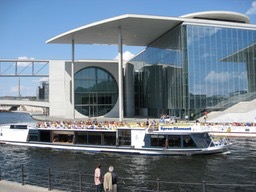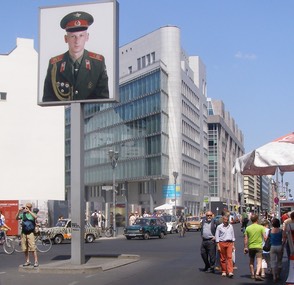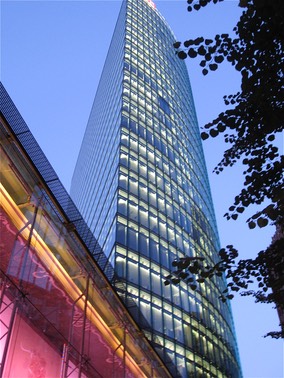By Ian Stuart Campbell. FSAI Hon FRIAS

Few cities can boast buildings by Norman Foster, Richard Rogers, Helmut Jahn, Renzo Piano, Hans Hollien, James Stirling, Rem Koolhaas, Frank Gehry, I.M.Pei, Jean Nouvel, Peter Eisenman, Daniel Libeskind, David Chipperfield, OMA, 3XN, and more. Yet a short afternoon stroll around Berlin can take in works by all of them. More forethought could include further greats from previous generations such as Le Corbusier, Mies van der Rohe and Schinkel.
This architectural showcase is a result of very particular circumstances. War followed by peacetime partition led Berlin to very dark times. The German Democratic Republic (GDR) constructed the Berlin Wall [August 1961] initially as a barbed wire fence isolating West Berlin. It became the wide clearing “death strip” extending 96 miles.

A building program by IBA [International Building Exhibition] began to develop gap sites caused by the Wall within West Berlin [1987]. IBA intended to encourage local architects, diversity and careful urban redevelopment. Architects from 15 countries responded to invitational design competitions. Once the wall was removed in 1989 regeneration created plentiful opportunities for this international architects’ Who's Who. Many were already in Berlin and keen to design prestigious government, diplomatic and commercial commissions.
Master plans were prepared for derelict areas such as Potsdammer Platz. Pre-war this had been Europe’s busiest centre. It became the world’s biggest building site. Daimler-Benz appointed Renzo Piano to build their 20 storey offices and to oversee 19 other adjacent buildings, while Hans Kollhoff designed his 25 storey centre piece Kolhoff Tower.

Helmut Jahn challenged the masterplan further with his 26 storey curved glass tower with an elliptical public space beneath a tented roof – the Sony Centre. It also incorporates surviving parts of the Hotel Esplanade, as featured in ‘Cabaret’. The building had to be moved in one-piece over 75 metres and is now preserved behind dramatic sheer glass curtain walling.
Potsdammer Platz set standards for public realm which are now the envy of UK authorities. Materials and landscaping defines pedestrian, cycle and vehicle zones, while comprehensive underground parking integrates sensibly with underground railway stations, offices, and retail. Informal seating is abundant beneath decorative trees and canopies, which mitigate effects of adjacent tall buildings.
Spectacular new retail centres along Friedrichstrasse link seamlessly below ground while presenting varied architecture to street level. Jean Nouvel’s ‘Lafayette’ reflects the Parisian store. Its curved glass frontage is recognisable as a background to recent trendy car advertisements.
Extensive work has also restored surviving buildings throughout the city. Evidence remains in bullet holes that some of the fiercest war episodes occurred in Berlin. Facades show scars and holes which now contrast eerily with modern elevations.
The history of Berlin is long and complex. In 1991 the Bundestag voted to move the West German administration back from Bonn and Berlin regained Capital status.
Once more Berlin is a colourful artistic and cultural centre where opinions are freely voiced - often against architects, planners and designers. Berlin presents a surprisingly rich comprehensible and rewarding architectural narrative to enjoy and discuss. Just do not expect consensus.
[500 words]